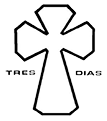Tres Dias Is Growing
Tres Dias Is Growing
Speaking at the Tres Dias Annual Assembly, July 13-15, Membership VP Beau Bruce reported that two new communities had received charters within the past twelve months: Southern Ontario Tres Dias (sponsored by Northern Virginia Tres Dias) and Alamo City Tres Dias (sponsored by Central Texas Tres Dias). Moreover, his committee is working with ten domestic and two international communities that are in various stages of meeting the charter requirements. 

 community and to provide “leadership, guidance, support and oversight in a loving manner.” The International Secretariat’s Membership Committee also commits to appointing a liaison to provide guidance. The emerging community, through its liaison, agrees to work with the other two liaisons to build a community that follows the Essentials. Together, they form a three-legged stool of support and cooperation.
This three-legged stool of support is a central part of the “New Community Startup Model.” At the core of this model is a 45-item check list and an accompanying Gantt Chart that guides the action from “notifying TDI Membership” through to the emerging community’s fourth set of weekends. After the fourth set of weekends working under the sponsor’s guidance, the community will likely be ready to apply for a charter.
This model is now in its sixth year of development and is now being used by all recognized emerging communities. “We’ve learned a lot from the different communities since implementing this program,” says Beau Bruce. “It has proved to be a very useful tool and universally accepted.”
community and to provide “leadership, guidance, support and oversight in a loving manner.” The International Secretariat’s Membership Committee also commits to appointing a liaison to provide guidance. The emerging community, through its liaison, agrees to work with the other two liaisons to build a community that follows the Essentials. Together, they form a three-legged stool of support and cooperation.
This three-legged stool of support is a central part of the “New Community Startup Model.” At the core of this model is a 45-item check list and an accompanying Gantt Chart that guides the action from “notifying TDI Membership” through to the emerging community’s fourth set of weekends. After the fourth set of weekends working under the sponsor’s guidance, the community will likely be ready to apply for a charter.
This model is now in its sixth year of development and is now being used by all recognized emerging communities. “We’ve learned a lot from the different communities since implementing this program,” says Beau Bruce. “It has proved to be a very useful tool and universally accepted.” Next Story
